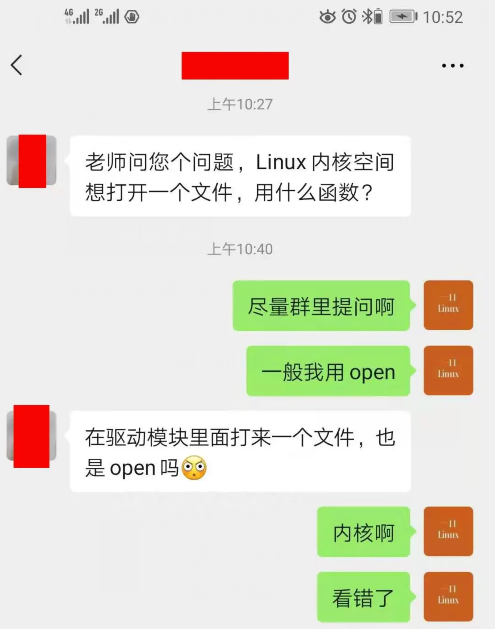詳解如何在內核中操作某個文件?
一、問題描述
如何在內核中操作某個文件?

問題
二、操作函數
1. 分析
在用戶態,讀寫文件可以通過read和write這兩個系統調用來完成(C庫函數實際上是對系統調用的封裝)。但是,在內核態沒有這樣的系統調用,我們又該如何讀寫文件呢?
閱讀Linux內核源碼,可以知道陷入內核執行的是實際執行的是sys_read和sys_write這兩個函數,但是這兩個函數沒有使用EXPORT_SYMBOL導出,也就是說其他模塊不能使用。
在fs/open.c中系統調用具體實現如下(內核版本3.14):
- SYSCALL_DEFINE3(open, const char __user *, filename, int, flags, umode_t, mode)
- {
- if (force_o_largefile())
- flags |= O_LARGEFILE;
- return do_sys_open(AT_FDCWD, filename, flags, mode);
- }
跟蹤do_sys_open()函數,
- long do_sys_open(int dfd, const char __user *filename, int flags, umode_t mode)
- {
- struct open_flags op;
- int fd = build_open_flags(flags, mode, &op);
- struct filename *tmp;
- if (fd)
- return fd;
- tmp = getname(filename);
- if (IS_ERR(tmp))
- return PTR_ERR(tmp);
- fd = get_unused_fd_flags(flags);
- if (fd >= 0) {
- struct file *f = do_filp_open(dfd, tmp, &op);
- if (IS_ERR(f)) {
- put_unused_fd(fd);
- fd = PTR_ERR(f);
- } else {
- fsnotify_open(f);
- fd_install(fd, f);
- }
- }
- putname(tmp);
- return fd;
- }
就會發現它主要使用了do_filp_open()函數該函數在fs/namei.c中,
- struct file *do_filp_open(int dfd, struct filename *pathname,
- const struct open_flags *op)
- {
- struct nameidata nd;
- int flags = op->lookup_flags;
- struct file *filp;
- filp = path_openat(dfd, pathname, &nd, op, flags | LOOKUP_RCU);
- if (unlikely(filp == ERR_PTR(-ECHILD)))
- filp = path_openat(dfd, pathname, &nd, op, flags);
- if (unlikely(filp == ERR_PTR(-ESTALE)))
- filp = path_openat(dfd, pathname, &nd, op, flags | LOOKUP_REVAL);
- return filp;
- }
該函數最終打開了文件,并返回file類型指針。所以我們只需要找到其他調用了do_filp_open()函數的地方,就可找到我們需要的文件操作函數。
而在文件fs/open.c中,filp_open函數也是調用了file_open_name函數,
- /**
- * filp_open - open file and return file pointer
- *
- * @filename: path to open
- * @flags: open flags as per the open(2) second argument
- * @mode: mode for the new file if O_CREAT is set, else ignored
- *
- * This is the helper to open a file from kernelspace if you really
- * have to. But in generally you should not do this, so please move
- * along, nothing to see here..
- */
- struct file *filp_open(const char *filename, int flags, umode_t mode)
- {
- struct filename name = {.name = filename};
- return file_open_name(&name, flags, mode);
- }
- EXPORT_SYMBOL(filp_open);
函數file_open_name調用了do_filp_open,并且接口和sys_open函數極為相似,調用參數也和sys_open一樣,并且使用EXPORT_SYMBOL導出了,所以在內核中可以使用該函數打開文件,功能非常類似于應用層的open。
- /**
- * file_open_name - open file and return file pointer
- *
- * @name: struct filename containing path to open
- * @flags: open flags as per the open(2) second argument
- * @mode: mode for the new file if O_CREAT is set, else ignored
- *
- * This is the helper to open a file from kernelspace if you really
- * have to. But in generally you should not do this, so please move
- * along, nothing to see here..
- */
- struct file *file_open_name(struct filename *name, int flags, umode_t mode)
- {
- struct open_flags op;
- int err = build_open_flags(flags, mode, &op);
- return err ? ERR_PTR(err) : do_filp_open(AT_FDCWD, name, &op);
- }
2. 所有操作函數
使用同樣的方法,找出了一組在內核操作文件的函數,如下:
這些函數的參數非常類似于應用層文件IO函數,open、read、write、close。
3. 用戶空間地址
雖然我們找到了這些函數,但是我們還不能直接使用。
因為在vfs_read和vfs_write函數中,其參數buf指向的用戶空間的內存地址,如果我們直接使用內核空間的指針,則會返回-EFALUT。
這是因為使用的緩沖區超過了用戶空間的地址范圍。一般系統調用會要求你使用的緩沖區不能在內核區。這個可以用set_fs()、get_fs()來解決。
在include/asm/uaccess.h中,有如下定義:
- #define MAKE_MM_SEG(s) ((mm_segment_t) { (s) })
- #define KERNEL_DS MAKE_MM_SEG(0xFFFFFFFF)
- #define USER_DS MAKE_MM_SEG(PAGE_OFFSET)
- #define get_ds() (KERNEL_DS)
- #define get_fs() (current->addr_limit)
- #define set_fs(x) (current->addr_limit = (x))
如果使用,可以按照如下順序執行:
- mm_segment_t fs = get_fs();
- set_fs(KERNEL_FS);
- //vfs_write();
- //vfs_read();
- set_fs(fs);
詳解:系統調用本來是提供給用戶空間的程序訪問的,所以,對傳遞給它的參數(比如上面的buf),它默認會認為來自用戶空間,在read或write()函數中,為了保護內核空間,一般會用get_fs()得到的值來和USER_DS進行比較,從而防止用戶空間程序“蓄意”破壞內核空間。
而現在要在內核空間使用系統調用,此時傳遞給read或write()的參數地址就是內核空間的地址了,在USER_DS之上(USER_DS ~ KERNEL_DS),如果不做任何其它處理,在write()函數中,會認為該地址超過了USER_DS范圍,所以會認為是用戶空間的“蓄意破壞”,從而不允許進一步的執行。
為了解決這個問題, set_fs(KERNEL_DS),將其能訪問的空間限制擴大到KERNEL_DS,這樣就可以在內核順利使用系統調用了!
在VFS的支持下,用戶態進程讀寫任何類型的文件系統都可以使用read和write這兩個系統調用,但是在linux內核中沒有這樣的系統調用我們如何操作文件呢?
我們知道read和write在進入內核態之后,實際執行的是sys_read和sys_write,但是查看內核源代碼,發現這些操作文件的函數都沒有導出(使用EXPORT_SYMBOL導出),也就是說在內核模塊中是不能使用的,那如何是好?
通過查看sys_open的源碼我們發現,其主要使用了do_filp_open()函數,該函數在fs/namei.c中,而在改文件中,filp_open函數也是間接調用了do_filp_open函數,并且接口和sys_open函數極為相似,調用參數也和sys_open一樣,并且使用EXPORT_SYMBOL導出了,所以我們猜想該函數可以打開文件,功能和open一樣。
三、實例
Makefile
- ifneq ($(KERNELRELEASE),)
- obj-m:=sysopen.o
- else
- KDIR :=/lib/modules/$(shell uname -r)/build
- PWD :=$(shell pwd)
- all:
- $(info "1st")
- make -C $(KDIR) M=$(PWD) modules
- clean:
- rm -f *.ko *.o *.mod.o *.symvers *.cmd *.mod.c *.order
- endif
sysopen.c
- #include <linux/module.h>
- #include <linux/syscalls.h>
- #include <linux/file.h>
- #include <linux/fcntl.h>
- #include <linux/delay.h>
- #include <linux/slab.h>
- #include <linux/uaccess.h>
- MODULE_LICENSE("GPL");
- MODULE_AUTHOR("yikoulinux");
- void test(void)
- {
- struct file *file = NULL;
- mm_segment_t old_fs;
- loff_t pos;
- char buf[64]="yikoulinux";
- printk("test()");
- file = filp_open("/home/peng/open/test.txt\n",O_RDWR|O_APPEND|O_CREAT,0644);
- if(IS_ERR(file)){
- return ;
- }
- old_fs = get_fs();
- set_fs(KERNEL_DS);
- pos = 0;
- vfs_write(file,buf,sizeof(buf),&pos);
- pos =0;
- vfs_read(file, buf, sizeof(buf), &pos);
- printk("buf:%s\n",buf);
- filp_close(file,NULL);
- set_fs(old_fs);
- return;
- }
- static int hello_init(void)
- {
- printk("hello_init \n");
- test();
- return 0;
- }
- static void hello_exit(void)
- {
- printk("hello_exit \n");
- return;
- }
- module_init(hello_init);
- module_exit(hello_exit);
編譯:

安裝模塊:

查看操作的文件:

查看文件內容:

可見在內核模塊中成功操作了文件。
































